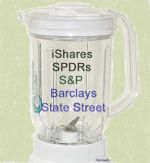 Despite the shrinking ETF universe, it can still be hard to keep the different players straight in your mind. In this article, I’ll try to help you understand how it works so you can tell who is who.
Despite the shrinking ETF universe, it can still be hard to keep the different players straight in your mind. In this article, I’ll try to help you understand how it works so you can tell who is who.
The first thing to remember is that all ETFs are based on an index of stocks, bonds, commodities or currencies. The SEC forbids fund sponsors from offering an ETF that tracks an index of their own design. This means that every ETF is a kind of joint venture between two companies: the index provider and the fund sponsor.
You see this in the fund names: iShares Dow Jones U.S. Basic Materials (IYM), for instance, is sponsored by iShares but follows an index designed and maintained by Dow Jones. iShares pays Dow Jones a license fee to use the Dow Jones U.S. Basic Materials Index as the basis for the ETF.
The words “Lehman Brothers” used to part of many bond index names, since Lehman was creator of many fixed-income indexes. After Lehman went bankrupt last fall, the index names had to change to identify the new index keeper. Today, most of the former Lehman indexes are Barclays Capital indexes. Barclays Capital happens to be the owner of iShares.
Here’s where it gets confusing. The two largest ETF brands, iShares and SPDRs, now find themselves in the unusual position of advertising each other’s products. The SPDR trademark belongs to the parent company of S&P. Therefore, the SPDR brand is often associated with S&P even though State Street manages the funds. However, as a result of the Lehman demise, most bond ETFs from State Street now begin with “SPDR Barclays Capital”.
Meanwhile, Barclays is the company behind the iShares brand, yet many of their ETF offerings are based on S&P indexes and have names that begin with “iShares S&P.”
Of course, it isn’t unusual for large companies to have these complex relationships with other firms being both competitor and customer at the same time. Usually it is not quite so obvious, though. We live in truly interesting times.